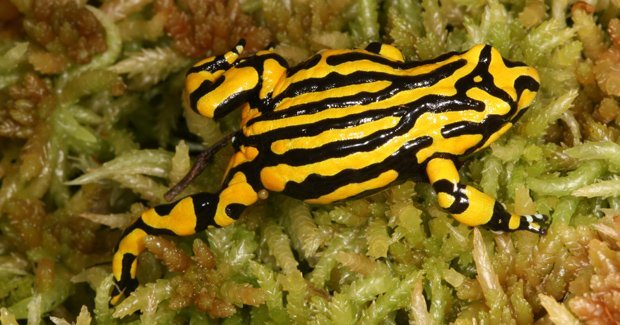Southern corroboree frog

IUCN status
Critically endangered
AUSTRALIAN CONSERVATION STATUS (EPBC Act)
Critically endangered
RANGE
Only in Kosciuszko National Park
HABITAT
Sphagnum bogs in sub-alpine woodlands, heathland and grassland 1300m – 1800m above sea level.
CLASSIFICATION
Kingdom Animalia
Phylum Chordata
Class Amphibia
Order Anura
Family Myobatrachidae
Genus Pseudophryne
Species: corroboree
ARGUABLY ONE OF the most striking of Australia’s species, the southern corroboree frog is endemic to Australia, and in fact only lives in small pockets entirely within Kosciuszko National Park.
Designated a species by John Moore in 1953, the southern corroboree frog grows to just 2.5-3cm. It derives its name from the black and bright yellow stripes – ‘corroboree’ refers to a meeting or gathering of Aboriginal Australians where participants often adorn themselves in white striped markings.
It has several genetic and visual differences to the northern corroboree cousins (such as a slightly more yellow colouring and different-sized stripes, as well as larger body size).
The frog reaches sexual maturity after four years and breeding occurs during a short period in summer (January-February). Females typically lay a clutch of about 25 eggs in a clutch (can be 10-40) in a small nest of vegetation near the edge of ponds.

The belly of the southern corroboree frog can sometimes be blue.
Threats to the southern corroborree frog
The southern corroboree frog has no natural predators because it oozes a toxin from its skin, an alkaloid called pseudophrynamine. However, it is threatened by other factors.
These threats include human impacts such as climate change, fire and habitat disturbance, as well as fire and feral animals. But the biggest problem is the chytrid fungus (Batrachochytrium dendrobatidis), which has been decimating frog populations around the world.
The fungus only infects the tadpoles and adult frogs that have keratin, which it needs to thrive. Frog eggs are immune because they contain no keratin.
In January 2014, the entire population of southern corroboree frogs was estimated to be fewer than 50 individuals in the wild. The population has declined by more than 99 per cent since the 1980s.
Conservation programs
A program to save the species includes collaboration of the NSW Office of Environment and Heritage with Amphibian Research Centre, Taronga Zoo, Melbourne Zoo, and Healseville Sanctuary to save the species and breed the frog eggs and realease them into the wild.
Since 2010, hundreds of eggs have been released into the frog’s natural habitat in Kosciuszko NP and each year since, more eggs have been reintroduced. The program is achieving some success, with breeding and production of viable eggs from those that were reintroduced.

Three southern corroboree frogs about to be released into the
quarantined site in Kosciuszko NP. Credit: Lucy Morrell
More information
www.corroboreefrog.com.au
Federal Dept of Environment
IUCN listing: southern corroboree frog

